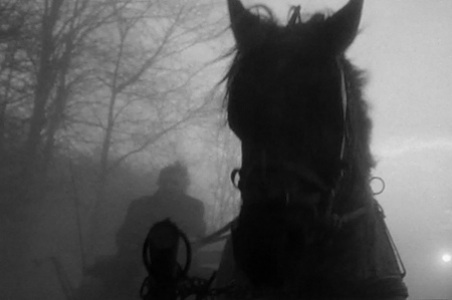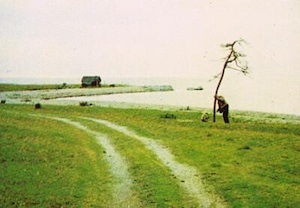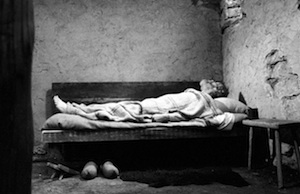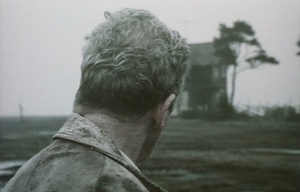The Sacrifice was Andrei Tarkovsky’s final film; the great Russian director was diagnosed with lung cancer during editing and died shortly after it was completed. Set in Sweden in the 1980s, it’s about a former actor who offers to sacrifice all he has in order to spare the world from a nuclear holocaust.
Although in good health, Béla Tarr has said that The Turin Horse will be his final film. When asked why, Tarr replies that he’s said everything he had to say and doesn’t want to repeat himself. The Turin Horse recounts six grueling days in the lives of an Italian farmer and his daughter in 1899—living through what is possibly the end of the world.
While these two “final” works don’t appear to have much in common superficially, they share key thematic and structural elements that tell us a great deal about each director’s philosophy and his worldview.
The Love of the Long Take
Both Tarr and Tarkovsky are/were devout practitioners of the tracking shot. Any self-respecting list of the top tracking shots in film history should include the works of both men. For Tarr, it would be the opening shot of Satantango; for Tarkovsky, it might be something from Stalker, or The Mirror—or the first post-credits shot in The Sacrifice.
In that initial shot, we watch our protagonist, Alexander, planting a withered tree with his young son, Little Man, as Alexander recounts a Zen parable. Otto the postman rides up on his bicycle bearing birthday greetings for Alexander and encourages him to stop waiting and start living. The camera tracks the three characters as Otto rides in circles while Alexander and Little Man make their home. The Sacrifice might be the most deliberate of all of Tarkovsky’s films: Its 149-minute running time comprises just 115 shots, with many lasting 6 to 8 minutes.
The Turin Horse runs an almost identical 146 minutes, yet comprises just 30 shots, and is almost bereft of dialogue. Watching Tarr’s and Tarkovsky’s films in succession can be a jarring experience: I remembered The Sacrifice as languid and deliberate, but it seemed frenetic compared to The Turin Horse.
The house in which The Turin Horse takes place was built specifically for the shoot, as was the house in which The Sacrifice was set. (The house in The Sacrifice had to be built twice, actually; once for the bulk of principal photography, and again when Tarkovsky had to reshoot the film’s final scene, in which the house is destroyed, because of camera malfunctions.) This purpose-built house allowed Tarr and longtime cinematographer Fred Kelemen to light the interior shots naturalistically and edit in the camera, resulting in improbably long and powerful tracking shots that hammer home the tedium of the protagonists’ lives.
Nietzsche and Amor Fati
While the anti-philosopher casts a long shadow across the entire history of Western cinema, he is referenced specifically in both The Sacrifice and The Turin Horse.
The Turin Horse, of course, takes its inspiration from a Nietzsche anecdote. The German philosopher is said to have witnessed a cabman savagely beating his stubborn horse, and it’s this incident that precipitated Nietzsche’s mental breakdown. Tarr recounts this incident at the beginning of the film in voice-over, and then cuts to a long tracking shot (what else!) of a cab driver (Ohlsdorfer, played by Janos Derzsi) driving his lathered horse across a windswept landscape.
But Nietzsche’s presence doesn’t end there. There are only two scenes in the film that include (human) characters other than Ohlsdorfer and his daughter: a brief scene when a band of gypsies descend on the farmhouse, and a longer scene wherein their neighbor, Bernhard, pays a visit to borrow some palinka. Bernhard gives voice to some of Nietzsche’s most famous sentiments as part of his monologue: “And all at once they realized that there is neither god nor gods. All at once they saw that there is neither good nor bad.”
Tarkovsky, the Russian Orthodox auteur, also invokes Nietzsche, but to a very different end.
In that very first post-credit scene with Alexander and Little Man, Otto arrives and begins talking about Nietzsche’s dwarf—a reference to Nietzsche’s doctrine of Eternal Return. In fact, there is evidence that Tarkovsky considered calling his final film “Eternal Return” before settling on “The Sacrifice.”
Tarr bristles when compared to the Russian master: When a critic referred to him as a ‘despiritualized Tarkovsky,’ Tarr replied ‘Tarkovsky [is] religious and we are not. But he always had hope; he believed in God. … he’s too nice for me.’
But ultimately it would seem that Tarkovsky rejects Nietzsche’s amor fati; after all, by making his sacrifice, Alexander alters not only his own fate, but also the entire course of history—a straightforward Christian view of suffering and redemption.
It’s the End of the World .. Or Is It?
Both films are set against the backdrop of an apocalypse—maybe. It’s actually unclear if the world is ending in The Turin Horse, but it seems likely. Darkness falls over the farmhouse in midday, and the lamp won’t light, despite being full of oil. The laws of nature no longer hold. Ohlsdorfer’s daughter is mystified; Ohlsdorfer himself seems resigned. “What is all this?” she asks.
I don’t know. Let’s go to bed.
Even the embers went out.
Tomorrow we’ll try again.
Is this a rare note of hope from Tarr, or is it merely resignation? Perhaps this a nod to, or a validation of, Nietzsche’s notion of Eternal Recurrence: Tomorrow, or in the next life, father and daughter will get up, dress, toil, eat potatoes and stare out the window. It also invokes the dark humor of Beckett. Like Vladimir and Estragon in Waiting for Godot, the only option Ohlsdorfer and his daughter have is to carry on.
As in The Turin Horse, we don’t ever see the apocalypse in The Sacrifice. Once he hears the bombers and the news reports of the impending nuclear war, Alexander takes action. At Otto’s urging, he forsakes all he has, including his family and his home, to save humanity. The nuclear holocaust does not come to pass, but we’re left wondering if Alexander’s sacrifice actually changed history, or if he imagined the entire thing.
The mere possibility of redemption instantly distinguishes Tarkovsky from Tarr. Tarr bristles when compared to the Russian master: When a critic referred to him as a “despiritualized Tarkovsky,” Tarr replied “Tarkovsky [is] religious and we are not. But he always had hope; he believed in God. … he’s too nice for me.”
Inextricably Linked
No matter how vociferously Tarr might deny it, the similarities between The Sacrifice and The Turin Horse are undeniable. The long tracking shots, the ambiguous apocalypse, the presence of Nietzsche… Coincidence? Or was Tarr’s film a response to The Sacrifice and Tarkovsky in general?
Perhaps the things Tarr still needed to say in this “final” piece are precisely the big existential questions that every filmmaker, including Tarkovsky, grapples with. We may never know intent, even as The Sacrifice and The Turin Horse will be mentioned in the same (long) breath for decades to come.







